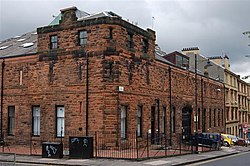History
The building was designed by Horatio Kelson Bromhead as the headquarters of the 1st Volunteer Battalion the Highland Light Infantry [1] and completed in 1897. [2]
This unit became the 5th (City of Glasgow) Battalion, The Highland Light Infantry (Territorial Force) in 1908. [3] [4] The battalion was mobilised at the drill hall in August 1914 before being deployed to Gallipoli and then to the Western Front. [5]
It became the home of 5th/6th Battalion, the Highland Light Infantry, on amalgamation with the 6th (which had been based in the Yorkhill Street drill hall), [6] 10th and 11th Battalions of the Highland Light Infantry in 1947. [7]
Colours flying, the 5/6th Battalion, the Highland Light Infantry marched from the Hill Street drill hall to amalgamate with the Glasgow Highlanders to form a company of the 52nd Lowland Volunteers at the Hotspur Street drill hall in 1967. [7]
The drill hall was then decommissioned and converted for academic use: it is now known as the Haldane Building, named after the Glasgow engraver James Haldane, and is part of the Glasgow School of Art. [8]
This page is based on this
Wikipedia article Text is available under the
CC BY-SA 4.0 license; additional terms may apply.
Images, videos and audio are available under their respective licenses.

